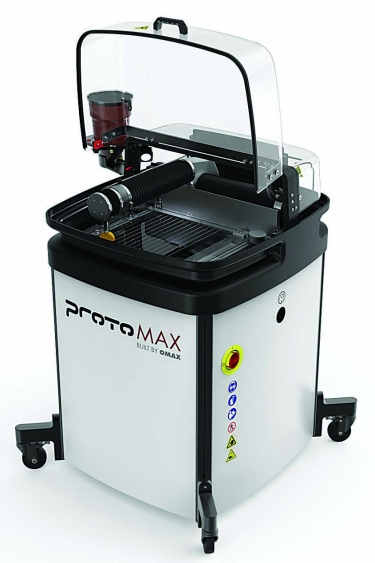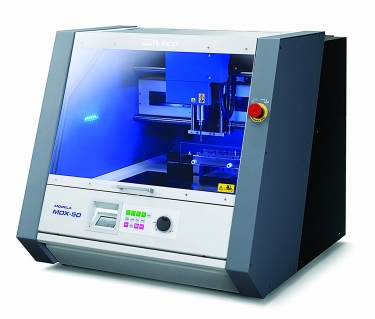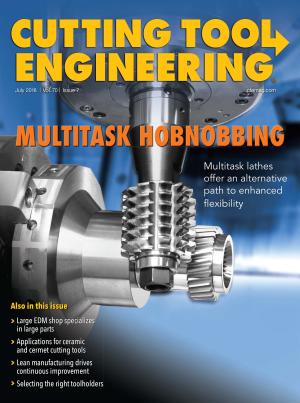If you were asked to imagine a machine tool, chances are you’d conjure up a hefty beast with a hefty price tag. You may be surprised to discover, therefore, that there are relatively small, budget-friendly machines on the market that can meet the requirements of certain industrial cutting applications.
Take the ProtoMAX, an abrasive waterjet machine built by OMAX Corp., Kent, Wash. With a footprint of about 41½"×39½", the machine weighs approximately 750 lbs. with water in the tank.

The ProtoMAX waterjet machine may be small, but it can cut virtually any material. Image courtesy of OMAX
Compare that with OMAX’s next smallest waterjet cutter, which has a footprint of about 5'3"×12', not including the pump, which covers another 4'×5', according to Stephen Bruner, the company’s vice president of marketing.
Besides consuming less space, the ProtoMAX is built on casters, which allow the compact unit to be rolled from one location to another.
This mobility is helpful during both installation and reconfiguration of a machine shop. “Instead of requiring a forklift and a bunch of people, installation of the ProtoMAX can be a one-man operation,” Bruner said.
In addition to being easy on shop personnel, the ProtoMAX is easy on shop budgets. Whereas standard smaller waterjets typically start in the $70,000 to $75,000 range, Bruner noted, the ProtoMAX is priced at $19,950, including shipping, in the U.S.
According to Bruner, the ProtoMAX can cut any material up to about 1" thick. As its name suggests, prototyping is one of the machine’s main applications. But it’s also used by some businesses in a production capacity, he added.
In production environments, however, the ProtoMAX has significant limitations. The cutting area measures just 12" square, and the machine allows only a little over an inch of adjustment in the Z-axis direction. By contrast, Bruner said, an industrial-size waterjet may have a Z stroke of as much as 12".
In addition, the waterjet uses a 5-hp pump. The good news is that the unit requires only a single-phase 240v power supply rather than the three-phase power required by typical waterjet pumps, which are at least 20 hp. The downside, however, is that the ProtoMAX pump can generate only 30,000 psi of water pressure. This means the pump can’t deliver the cutting speeds of industrial pumps capable of producing water pressures up to 100,000 psi.

A benchtop CNC milling machine, the MDX-50 can handle
light-duty prototyping and production. Image courtesy of Roland DGA
Besides being large and expensive, conventional CNC machine tools require a skilled machinist or CNC programmer to operate them. But the DGShape line of benchtop CNC mills from Roland DGA Corp., Irvine, Calif., includes a CAM software package that addresses this challenge. The package is designed to allow a novice engineer, student or educator who has no CNC training to operate the machines within a few minutes of learning how to use the software, according to Adam Sebran, Roland DGA’s business development manager for 3D and education products.
Like the ProtoMAX, DGShape benchtop mills don’t require three-phase power. Instead, they operate on household 110v electricity. The idea, Sebran said, is “to provide an easy-to-use solution that is office environment-friendly for engineering departments and educational institutions.”
DGShape mills can also function in industrial settings, handling light-duty prototyping and production, as well as secondary machining operations. But running at 12,000 to 15,000 rpm, Sebran said, these small, low-torque machines “aren’t going to take ½" industrial bites out of a block of steel or aluminum.”
Unveiled last year, the 3-axis MDX-50 is the newest addition to the DGShape lineup. Weighing in at 269 lbs., the mill measures 30"×35"×29", including the built-in safety enclosure. The machine can mill wood, plastics, nonferrous metals, wax and foam in its 15½"×12"×4" process area.
Though not as capable as conventional machine tools, the MDX-50 takes a much smaller bite out of a company’s financial resources. The unit’s list price is $10,995; an optional rotary fourth axis costs an additional $3,995.
“So for about $15,000, you get a fully loaded CNC machine,” Sebran said.
Related Glossary Terms
- abrasive
abrasive
Substance used for grinding, honing, lapping, superfinishing and polishing. Examples include garnet, emery, corundum, silicon carbide, cubic boron nitride and diamond in various grit sizes.
- abrasive waterjet ( AWJ)
abrasive waterjet ( AWJ)
System that uses high-pressure waterjets in combination with a slurry of fine abrasive grains to machine materials. See waterjet cutting.
- computer numerical control ( CNC)
computer numerical control ( CNC)
Microprocessor-based controller dedicated to a machine tool that permits the creation or modification of parts. Programmed numerical control activates the machine’s servos and spindle drives and controls the various machining operations. See DNC, direct numerical control; NC, numerical control.
- computer-aided manufacturing ( CAM)
computer-aided manufacturing ( CAM)
Use of computers to control machining and manufacturing processes.
- gang cutting ( milling)
gang cutting ( milling)
Machining with several cutters mounted on a single arbor, generally for simultaneous cutting.
- milling
milling
Machining operation in which metal or other material is removed by applying power to a rotating cutter. In vertical milling, the cutting tool is mounted vertically on the spindle. In horizontal milling, the cutting tool is mounted horizontally, either directly on the spindle or on an arbor. Horizontal milling is further broken down into conventional milling, where the cutter rotates opposite the direction of feed, or “up” into the workpiece; and climb milling, where the cutter rotates in the direction of feed, or “down” into the workpiece. Milling operations include plane or surface milling, endmilling, facemilling, angle milling, form milling and profiling.
- milling machine ( mill)
milling machine ( mill)
Runs endmills and arbor-mounted milling cutters. Features include a head with a spindle that drives the cutters; a column, knee and table that provide motion in the three Cartesian axes; and a base that supports the components and houses the cutting-fluid pump and reservoir. The work is mounted on the table and fed into the rotating cutter or endmill to accomplish the milling steps; vertical milling machines also feed endmills into the work by means of a spindle-mounted quill. Models range from small manual machines to big bed-type and duplex mills. All take one of three basic forms: vertical, horizontal or convertible horizontal/vertical. Vertical machines may be knee-type (the table is mounted on a knee that can be elevated) or bed-type (the table is securely supported and only moves horizontally). In general, horizontal machines are bigger and more powerful, while vertical machines are lighter but more versatile and easier to set up and operate.
- milling machine ( mill)2
milling machine ( mill)
Runs endmills and arbor-mounted milling cutters. Features include a head with a spindle that drives the cutters; a column, knee and table that provide motion in the three Cartesian axes; and a base that supports the components and houses the cutting-fluid pump and reservoir. The work is mounted on the table and fed into the rotating cutter or endmill to accomplish the milling steps; vertical milling machines also feed endmills into the work by means of a spindle-mounted quill. Models range from small manual machines to big bed-type and duplex mills. All take one of three basic forms: vertical, horizontal or convertible horizontal/vertical. Vertical machines may be knee-type (the table is mounted on a knee that can be elevated) or bed-type (the table is securely supported and only moves horizontally). In general, horizontal machines are bigger and more powerful, while vertical machines are lighter but more versatile and easier to set up and operate.


